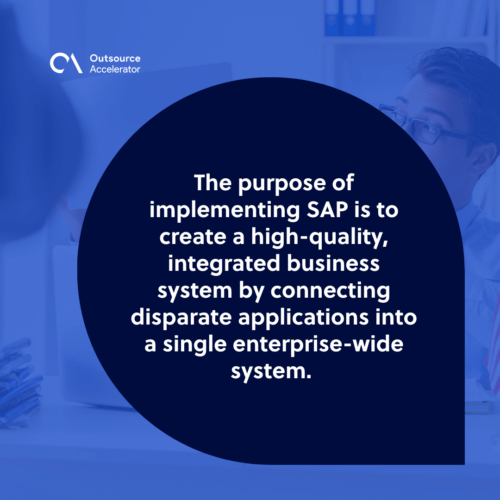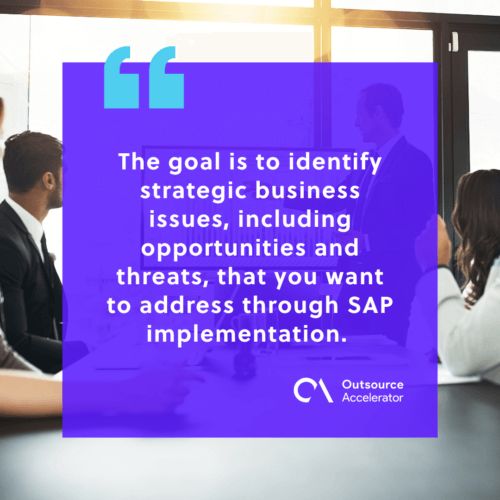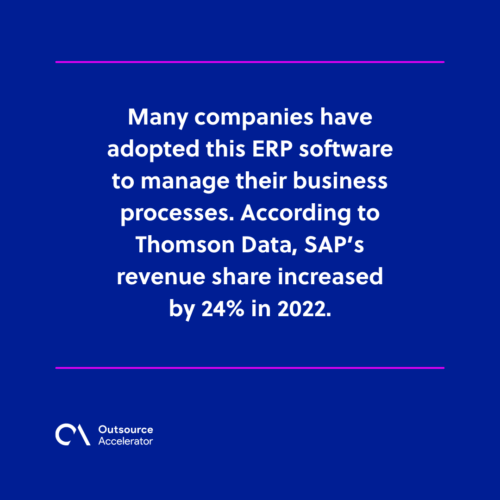How a successful SAP implementation works

Systems, Applications, and Products in Data Processing (SAP) was developed by the German company SAP SE to provide a comprehensive suite of business applications.
SAP is a comprehensive enterprise resource planning (ERP) software solution streamlining and automating various business functions. Examples of these functions include finance, human resources, sales, and inventory management.
SAP is a formidable player, and SAP implementation can revolutionize the way your business operates.
What is SAP implementation?
SAP implementation is the process of setting up and configuring SAP software in your organization. This involves installing and configuring the SAP software on a server, integrating it with other systems, and training staff to use it.
SAP implementations can be complex and time-consuming. They usually require a large team of professionals with expertise in the following areas:
- Software installation
- System integration
- Security
- Business process analysis
- Change management
The purpose of implementing SAP is to create a high-quality, integrated business system by connecting disparate applications into a single enterprise-wide system.

Brownfield vs. Greenfield approaches for SAP implementation
SAP implementation is a complex and lengthy process. It is important that you choose the right approach for your company.
There are two approaches to SAP implementation:
Brownfield approach
A system already exists with a Brownfield SAP implementation, and you’ll just be upgrading it to a new version. This is beneficial if you have no major issues with your current system and you simply want to upgrade to a newer version.
The SAP implementation team takes into account the following:
- The current configuration of your IT landscape
- Outside systems and applications that interact with SAP
- Customizations that you’ve made to your system over time
A Brownfield approach also ensures less disruption during the SAP implementation process. This is a strong, attractive point for companies that have invested heavily in their current software solutions.
Greenfield approach
The Greenfield approach starts you from scratch with no existing systems in place. This SAP implementation approach allows you to build your business processes from the ground up using SAP’s best practices and latest technology.
The Greenfield approach is best suited for companies that want to get rid of old legacy systems and move towards more efficient and effective solutions.
As with the Brownfield approach, an assessment must be conducted.
The project team reviews current business processes and determines the need for an ERP system. The business needs are then translated into a functional requirements document to determine the scope of work.
The most important part of the Greenfield approach to SAP implementation is testing. The project team must test all critical functionality before going live to ensure it meets all user expectations.
Phases of SAP implementation
SAP implementation is a complex process involving different phases and people, both internal and external, in your company.
These phases may vary by organization, but there are certain similar phases most companies go through:
Project preparation and planning
The first step in SAP implementation is gathering preliminary information about the project. Project planning involves developing a detailed scope statement that describes all activities involved in SAP implementation.
This also includes creating a detailed schedule for each phase and allotted resources.
Business blueprint
To guide your project planning, it’s helpful to create a business blueprint. This identifies the business requirements and designs of data models, reports, and screens.
The goal is to identify strategic business issues, including opportunities and threats, that you want to address through SAP implementation.
During this phase, you’ll also conduct a gap analysis. This is an in-depth study that maps out all the gaps between your current state and your desired end state.
Realization
This phase of SAP implementation creates a logical design for the new system, including how data will flow between departments. The project team designs a map of all hardware, software, network architecture, and other technical requirements for SAP implementation.
Developers code all modules required and create any customizations for unique functionality.
Final preparation
After building code and configurations, it’s time to test all components before moving into production. Functional teams work together to verify that everything works as expected once deployed.
Documentation is also done to record how the new system differs from the legacy one. Project managers train employees on how to use the new system and make sure any old business processes have been eliminated or changed.
Go live and support
Finally, you will go live with your SAP implementation. All systems will have been integrated, and data updates will automatically be reflected across the entire structure.
The primary concern of managers will be providing technical support to end users as they transition to new processes and tools.

Tips in choosing a SAP implementation partner
The success of SAP depends on the ability of IT professionals to implement the software successfully. The implementation process involves taking information from existing systems and putting it into SAP.
This can be a difficult task because it requires careful planning, testing, and training of users before going live with the system.
Many companies have adopted this ERP software to manage their business processes. According to Thomson Data, SAP’s revenue share increased by 24% in 2022.
However, implementing SAP is not an easy task. You need an expert partner who can ensure that your business operations are up and running smoothly.
Here are some tips on how to choose a good implementation partner:
- Choose a partner who has experience in implementing SAP in your industry.
- Make sure it has a team of experts who can handle any situation during SAP implementation.
- Check if they have enough resources to implement the project within the timeline specified by you.
- Ask if they have access to an implementation toolkit with best practices and tools designed specifically for your business needs.
- Ensure that they provide post-implementation support services.

Why choose SAP implementation?
SAP is the leader in enterprise resource planning (ERP) software, with more than 400,000 customers worldwide.
It’s also one of the most recognized brands in the software industry. The company offers a wide range of products and services that can help your organization grow and improve efficiency.
Choosing SAP implementation gives you access to all these tools under one roof — from financial management and supply chain management to human resources and customer relationship management (CRM).
The benefits of implementing SAP include:
- Increased efficiency in business operations
- Improved decision-making capability by providing real-time data
- Better customer service through enhanced customer relationship management (CRM) capabilities
- Improving the availability of data across the enterprise







 Independent
Independent




